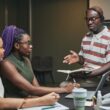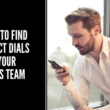Lead, Prospects And Opportunities
A B2B lead can be any person who has shown interest in your product or service in any way, shape or form. Possible sources include;-
-
- A list of qualified leads bought from a third party vendor or someone you’ve researched yourself
- Referrals from your customers
- People who’ve positively responded to your sales or marketing campaigns like cold calls, cold emails, etc.
- People who reach out to you after seeing your blogs, videos, podcasts, ads, etc.
-
-
-
- Marketing Qualified Lead (MQL) – these are contacts who have engaged with your marketing efforts but are not necessarily ready to buy from you just yet. For instance, this is someone who has signed up for your newsletter only.
- Sales Qualified Lead (SQL) – these are people who have expressed their interest in becoming a customer. For instance, this is someone who has signed up your contact form to ask for additional information about your product. Additionally, SQL’s match your ideal customer profile, which is also an important part of evaluating the relevance of a lead.
-
What Is B2B Lead Generation?
Now that you know the basic differences between leads, prospects and opportunities, let’s explore the process of lead generation. Simply put, this is when you attract and convert people into leads or prospects through outbound and inbound campaigns. This could include (but is not limited to) cold calls, cold emails, blogs, ads, webinars, events, etc. The reason why it is so important to have a lead generation process in place is because it guides you throughout an individual’s journey to becoming a customer. It contains all the efforts (and steps) you need to undertake to attract your audience, convert them, close the deal and delight them or keep them coming back for more. So, the more leads you have, the more you will sell – business 101!
Lead Generation Process
The debate raging around inbound vs outbound – and which method is superior for B2B lead generation – tells us that many marketers and salespeople are still divided on the best way to get more customers. Those in favor of inbound often cite inbound marketing statistics like;
-
-
- Content marketing yields three times as many leads as paid search ads [Content Marketing Institute]
- Content marketing costs 62% less than outbound campaigns [Content Marketing Institute]
- Only 18% of marketers believe that outbound channels yield the highest quality leads [HubSpot]
-
-
-
- There are over 3.9 billion active email users worldwide – that’s over half of the global population [The Radicati Group, Inc.]
- From 2018 to 2023, email use is predicted to grow by 2% to 3% every year [Statista]
- Including a video in your emails can increase click-throughs by 300% [Martech Advisor]
-
Lead Generation Through Inbound Marketing
Optimize Your Website
Everything starts with your site – consider it as the first impression of your brand or your business’s identity. If your website is not optimized, then no matter what you do – run paid ads, social media marketing, etc. – it will not work since visitors will not convert. In other words, your website has to be optimized through attention grabbing CTAs, lead forms, quality how to guides, etc.Don’t Forget To Engage With Your Visitors
In short, you need to make it easier for visitors to start a conversation with you – at any time, be it day or night – and ensure that all queries or requests are answered asap. After all, about 30 to 50% of deals go to companies that actually respond first. And even though this sounds a bit daunting, you have to keep in mind that incorporating something as simple as a live chat, a chatbot or a help center will certainly pay for itself in the long run. For small businesses that can’t set aside a budget to hire round the clock sales reps, automation is the best option.Build Online Communities
And no, we don’t mean that you should create a Facebook group, share something once a week and be done with it. What I mean is that building an online community around your brand or problems that your products solve involves a lot of effort and hard work. We suggest that you start off by tapping into platforms that are underrated and aren’t commonly used for this purpose (yet); examples include Quora and Reddit. But don’t just build a company profile here, build a personal profile, answer questions related to your industry, share informative content – in short, set yourself up as a thought leader. As a general rule for all platforms, include pictures, videos, infographics, etc. in your answers. This tends to attract 48% more views on social media compared to plain text answers and posts. Most importantly, don’t forget to use the right hashtags for both text and images with a tool like RiteTag. Here’s what the CEO, Saul Fleischman, has to say:“Hashtags have never waned in their ability to get our posts discovered by more of our followers but also from those not following us. This will continue and be just as important in 2020 in all social and content networks where people can click on a hashtag or search it for posts with the hashtag and where hashtags are used by those who set things like paper.li, Instapaper, glos.si, etc. to automatically curate from posts containing a hashtag and republish our posts so they’re discovered by even more people – whether or not they follow us.”
Automate As Much As You Can
First rule of sales and marketing – automate manual processes as much as you can. For instance, your lead forms should be connected with your CRM and this data should be made available to the email outreach platform of your choice. Other examples of marketing automation include trigger based emails (for instance, when a user visits your pricing page), sequence of automated emails for new sign ups (for faster onboarding), social media automation (sharing content from specific sources, thanking new followers, etc.).Guest Blogging On Sites
There are many places where you can put up blogs on besides your website. For instance, Medium allows you to self-publish pieces while Inc., Entrepreneur magazine, etc. vet guest writers before accepting submissions from them. Whichever way you go (and we say that you do both), try to always include relevant information and never forget to link back to your site.Publish Interactive Content On Your Site
Games, quizzes and even free tools on your site tend to attract a ton of traffic – just ensure that the content is relevant to your audience. This way, you’ll (mostly) attract the right audience and encourage them to engage with your site, thereby increasing your dwell time, decreasing your bounce rates and a host of other such benefits that will uplift your B2B lead generation and sales.Keep Interested Leads Coming Back For More With Newsletters
Use a SaaS solution like Mailchimp to capture contacts through pop ups, sign up forms and landing pages (in exchange for valuable content). Send them weekly updates on the latest in your industry/business or even new features in your products/services. Not only will they thank you for it, but this will also keep your MQLs engaged until a time they convert. Afterwards, the newsletter will help you retain and ‘delight’ your customers, and keep them coming back to your website.Lead Generation Through Outbound Sales
In recent times, outbound marketing has been proclaimed as ‘disruptive,’ ‘irrelevant’ or even ‘dead’ while inbound gets all the praise. We’re here to tell you that this is simply not true. Outbound sales or techniques are still very much alive and effective – they have just changed to cater to modern audiences and buying trends.Personalization Is The Name Of The Game
What we are referring to here is personalization in all its glory and how technology has blurred the line between inbound and outbound. This has led many people to argue that personalized outbound (such as re-targeting PPC campaigns) is in fact, inbound. Let’s clarify this a bit here with the help of an example. Consider pay per click campaigns – while they were traditionally thought of as outbound, the introduction of dynamic retargeting has led them to be labeled as inbound since marketers can reach users based on their interests. We simply call this personalization – let’s look at another example. With the help of data like firmographics and behavioral data, you can send highly personalized email campaigns to users who might be actively looking for your solution. This doesn’t make it inbound since you’re still reaching out to your target accounts – the only difference is that you’re doing it at the right time, to the right people and with the right information. Simply put, outbound methods now embody the very spirit of what has made inbound so popular with both marketers and customers. According to an article on Woodpecker, you can more than double your reply rates – from 7% to 17% – by personalizing certain elements of your email (besides including the first name of the recipient instead of a simple ‘hello.’) This includes complimenting your prospect on a recent promotion, citing an article they wrote, etc. Find out how custom data mined by Cloudlead can help you personalize your email campaigns today – request a demo today. With this said, here are a few ways you can incorporate outbound in your lead generation process.Sponsored Ads
Use these on Facebook, LinkedIn and Google to drive traffic to landing pages with clear CTAs. Include something of value such as a free ‘how-to-guide,’ consultation, etc.Referral Programs
Run an email campaign where you send current customers a discount offer or code if they refer your business. To automate this process, you can explore a solution such as Referral Rock – and remember, around 84% of B2B decision makers start the buying process with a referral. This is what Megan Mosley, Marketing and Operations Specialist at the firm has to say:“It’s been shown that this channel will continue to grow in relevance to B2B buying cycles and customers in 2020. Referrals prove time and time again to be a valuable and nurtured lead generation strategy (meaning highly likely to convert and remain loyal). This is why more B2B businesses are implementing rewards type programs than ever.”
Direct Mail
Physical or direct mail for B2B lead generation works because of one primary reason – the novelty of receiving highly personalized letters. In fact, with a partner like Letter Friend, you can even send actual handwritten notes with an invitation to view your demo. Here’s what Phillip Mastrotto, account executive at the company has to say about this medium;“Research and personalization is important for any successful outbound campaign. Of course, if you add in a personal touch like a handwritten note, it makes creating a relationship much easier.”
Cold Email
Still relevant, still as effective. Consider this; according to a report by Richardson, ‘gaining appointments’ and ‘getting to the right stakeholder’ is a major obstacle faced by salespeople. And one of the best ways to overcome these challenges and form a connection is through cold emails. But we don’t just mean mass emailing – remember personalization? Well that applies here as well. You need to have the right information on your prospects and accounts, such as their pain points and buying triggers. Armed with this data, you can connect with the right decision makers, gain appointments and close more deals. Read: Guide For Closing Leads From Cold Emails Here’s what Moaaz Nagori, Co-founder of Cloudlead has to say about cold mailing as a lead generation channel for B2B;“Cold emailing is essentially a numbers game and having the right data can be the difference between exceeding, achieving or missing your quota.”
Cold Calling
Effective cold calling is a winning strategy for creating a predictable revenue cycle. Cold calling generates a different brand of lead, mainly a high value lead and they are often more qualified than inbound leads. This is what Tito Bohrt, CEO of Altisales has to say about discovery calls and cold outreach;“In a discovery call you don’t discover anything, you help your prospect discover that they have a challenge that they have no idea about.”Here’s a link to the video where Tito talks about discovery calls – and how you can master cold calling; How to Run Discovery Calls – Outbound Sales Mastery And that’s it for today – we’ll keep updating this resource with more insights on B2B lead generation and how you can keep your pipeline filled with qualified prospects who’ll actually convert into paying customers. Learn how Cloudlead has helped hundreds of clients gain better insights into their target accounts. Ask for a sample list today.










